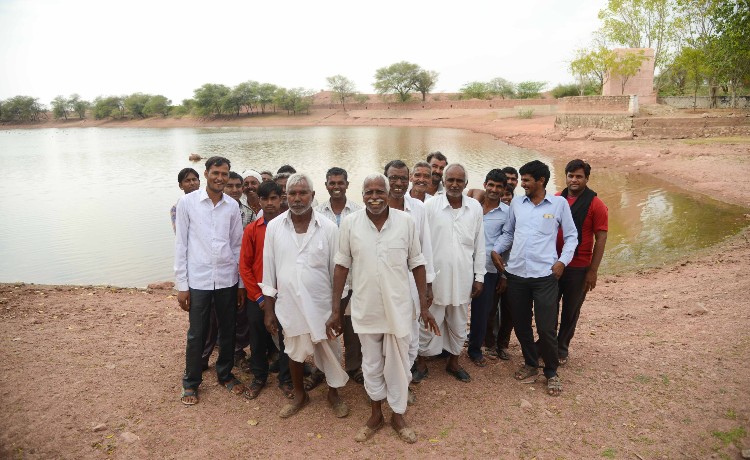India is one of the most vulnerable countries in the world to climate change risks, and nowhere will the impacts be felt more acutely, than in the area of water – particularly in water stressed rural areas, where livelihoods so desperately rely on natural resources, like water, for survival.
It has never been more crucial therefore, for rural communities to learn ways to ‘adapt’ to climate change and its impacts. Adaptation prepares communities for the consequences of climate change and simply means ‘doing things differently’ - because of climate change. However many barriers to adaptation exist, which threaten any development gains the country has made in the recent past, in areas like extreme poverty and hunger, gender equality and health indicators.
The need of the hour therefore, is for development sector agencies to more earnestly integrate adaptation strategies into their work, to help vulnerable communities, particularly in rural India, to cope with the impacts of climate change.
How Climate Change Impacts Rural Water
700 million people living in rural India depend on sectors that are sensitive to the climate for their livelihood and survival - like agriculture, forests and fisheries; heavily dependent upon natural resources such as water, biodiversity and grasslands as a result. The fragile nature of our natural resources (already under pressure from industrialisation, over population and growth) along with the staggering number of people who will be affected by climate variabilities, places India high on the vulnerability list.
When it comes to water reliant agriculture (the largest employer in the country with 51% of people dependent on it in one way or another), climate change is generating many impacts. Rising temperatures is increasing evaporation from surface water bodies, along with the irrigation water requirement and demands of farmers. Higher variability of rainfall is increasing the magnitude and frequency of drought, changing run-off patterns and increasing water pollution. High rainfall events catalyse floods and reduce infiltration of water to recharge groundwater - leading to reduced overall water availability and quality, for both farming and drinking water purposes.
For an already marginal sector, these impacts will see an ultimate decrease in food production (directly impacting livelihoods and national food security), an increase in rural-urban migration, and regression in many other development indicators like health, education and mortality rates.
Whilst adaptive measures exist, the adaptive capacity of dryland farmers (along with those who live in forests and fisher folk) is very low, with existing low incomes and prevailing poverty limiting their adaptive capacity, and the money they have available to invest in adaptation measures. It is therefore up to development sector agencies to play a key role in supporting these marginal rural communities in making the leap to plan for, and adapt to, climate change - which frankly is already upon us.
Key Barriers to Adaptation in Marginal Communities & Ways to Tackle Them
Many barriers exist when it comes to communities adopting adaptation measures. Limited resources and information – including knowledge, technology and finances to facilitate adaptation measures – make adopting changes prohibitive. Additionally, there are many social barriers to adaptation – psychological and behavioural ones that influence how people react to climate stress and change. Simply put, many people just do not like change, while others opt to ‘wait and watch’ for the impacts, before making changes – suffering the consequences as a result.
There is a need for much work in this area. Education about the negative impacts of climate change and adaptive measures is desperately required, and more importantly, investment and handholding during the process - people simply need guidance, advice and support as they try to navigate these trying times.
When it comes to water, development sector agencies have a crucial role to play in enabling farmers and rural communities to implement new water conservation and harvesting projects; better operate and maintain existing water harvesting structures; adopt more water efficient methods of irrigation like micro irrigation; improve soil health to better retain and use water; and save for extreme events like drought and floods.
But in order to do so, behaviour change communication, people’s participation and the fostering of ownership of projects is required to ensure success and the long term sustainability of adaptive measures.
Conclusion
Whilst it is an urgent global issue, climate change disproportionately affects developing countries like India – in particular the poor and vulnerable who live there. Climate adaptation measures are vital to safeguard the rural livelihoods the poor so heavily rely upon, and to ensure sustainable long term development.
The ripple effects of climate change mean that it is not just an environmental issue, and affects the economic and social aspects of sustainable development. Development agencies can no longer take a ‘development as usual’ approach to their work, without consideration of the risks and opportunities associated with climate change. Therefore, climate change risks need to be considered across the board in planning for development, in order to build in adaptation measures.
There is an urgent need for NGOs, CSR agencies and other development organisations, to build climate change adaptation into their strategies in order to enhance the climate resilience of those communities identified as most vulnerable to climate change. Rural India must be prioritised, for in the words of Gandhi, “India lives in her seven hundred thousand villages” and we as a country will surely feel the repercussions, if we do not.
- This article was originally posted on the CSR Box media platform
https://csrbox.org/Impact/description/Article_full_Implications-of-climate-change-on-water-utilities-and-the-need-for-adaptation-strategies_141







0 Comment